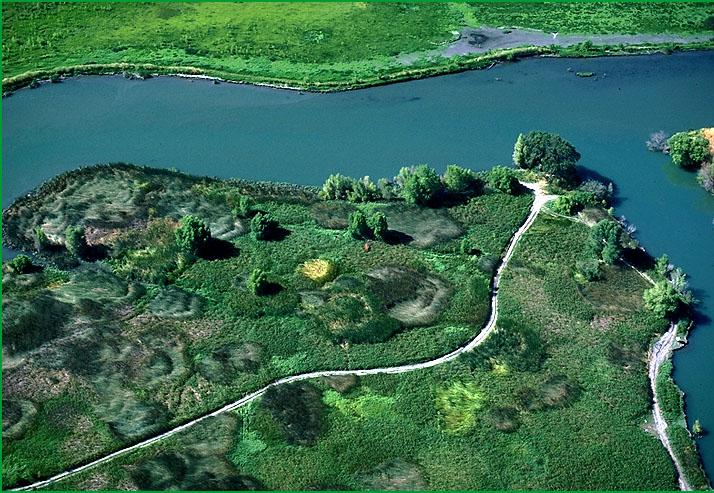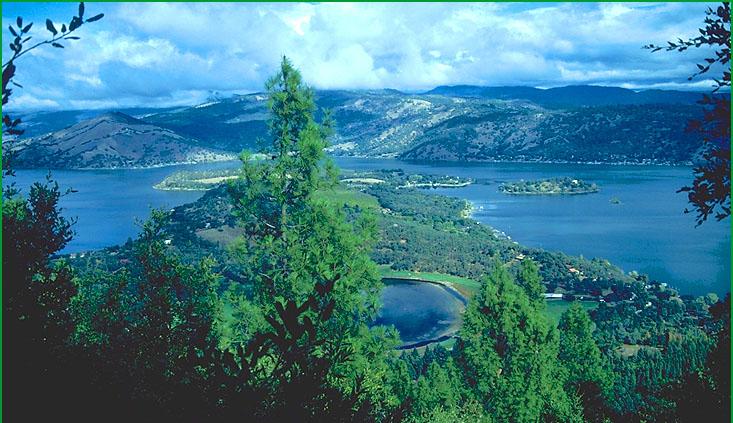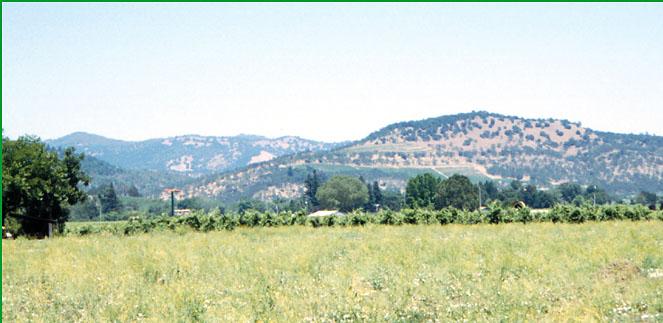 | Clear Lake Hills and Valleys- Konocti Flows - Ultrabasic Complex |
Clear Lake Hills and Valleys - Anderson Marsh area Ś James R. Nelson |
Mount Konocti area near Clear Lake Ś Robert Ettner |
Ultrabasic Complex-Napa Valley looking east Ś Scott Miles |
http://www.fs.fed.us/r5/projects/ecoregions/m261bd.htm
Subsection M261Bd
Clear Lake Hills and Valleys
This subsection is a relatively low part of the Northern Coast Ranges that is surrounded by mountains. Most of the Franciscan rocks in this basin have been covered by late Tertiary sedimentary and volcanic rocks. The volcanics are not included in this subsection. Clear Lake, the largest natural lake in the Coast Ranges, occupies much of this subsection. The subsection has a hot and subhumid climate. MLRA 14d.
Lithology and Stratigraphy. This subsection contains Jurassic and Cretaceous Franciscan rocks of the Central and Eastern Belts, nonmarine Plio-Pleistocene sediments, and Quaternary alluvium.
Geomorphology. This subsection is in a structural low, or graben, in the northern California Coast Range mountains. It contains moderately steep hills, highly dissected Plio-Pleistocene sediments, and nearly level to gently sloping Quaternary alluvial fans, terraces, and basin-fill. The elevation range is about 1300 feet to 2000 feet. Fluvial erosion and fluvial and lacustrine deposition in the basin bottom are the main geomorphic processes. Mass wasting is a minor process, except on ravine sideslopes in the highly dissected Plio-Pleistocene sediments.
Soils. Soils of Franciscan terrain are mostly Lithic Xerochrepts and Mollic Haploxeralfs. Those of gentle to moderately steep slopes that predominate in dissected Plio-Pleistocene sedimentary terrain are mostly Mollic Haploxeralfs. Fluventic and Cumulic Haploxerolls, Aeric Fluvaquents, Fluventic Haplaquolls, and Pelloxererts are common in alluvial fan and basin-fill deposits, and Ultic Palexeralfs on terraces. The hill and terrace soils are generally leached free of carbonates, but calcium carbonates and salts accumulate in basin-fill. Soil temperature regimes are thermic. Soil moisture regimes are xeric, except for some soils with aquic moisture regimes in alluvium around Clear Lake.
Vegetation. The predominant natural plant community is Blue oak series. Needlegrass grasslands, Valley oak series, Riparian habitats, and Emergent aquatic communities are common on alluvium and basin-fill around Clear Lake.
Characteristic series by lifeform include:
Grasslands: California annual grassland series.
Shrublands: Chamise series, Chamise - wedgeleaf ceanothus series, Scrub oak series.
Forests and woodlands: Blue oak series, California buckeye series, Foothill pine series, Interior live oak series, Knobcone pine series, Valley oak series.
Climate. The mean annual precipitation is about 20 to 40 inches. Most of the precipitation is rain, but some is snow. Mean annual temperature is about 50░ to 56░ F. The mean freeze-free period is about 150 to 200 days.
Surface Water. Runoff from hills and the Plio-Pleistocene sedimentary terrain is rapid and all but the larger streams are dry through most of the summer. Runoff is stored in and around Clear Lake and the lake level rises when runoff from the surrounding hills and mountains is more rapid than drainage from the Lake. There is some hydrothermal activity and accumulation of minerals from it, as in and around Borax Lake.
Subsection M261Be
Konocti Flows
This subsection is the volcanic terrain around Mt. Konocti and southeast from it. It has a hot, subhumid to humid climate. MLRA 15d.
Lithology and Stratigraphy. This subsection is dominated by silicic Quaternary volcanic rocks. The flows range from basalt or andesite to rhyolite, with the latter most prevalent, and there are interbedded pyroclastics.
Geomorphology. There are a few steep composite volcanic cone-shaped mountains, such as Mt. Konocti and Mt. Hannan, but most of the topography is gently sloping to moderately steep, somewhat chaotic terrain with a poorly integrated drainage system. The elevation range is from about 1300 feet up to 4722 feet on Cobb Mountain. Volcanic processes and fluvial erosion are the main geomorphic processes.
Soils. The soils are mostly Ultic and Mollic Haploxeralfs and lesser amounts of Palexeralfs and Lithic Haploxerolls. The soils are generally leached free of carbonates. Soil temperature regimes are mostly thermic, but are mesic on some north-facing slopes and at higher elevation. Soil moisture regimes are xeric.
Vegetation. The predominant natural plant communities are Chamise series on shallow soils; Mixed conifer series on moderately deep to deep soils with mesic soil moisture regimes; and Blue oak series, Mixed scrub oak series, and various other chaparral shrublands in other areas.
Characteristic series by lifeform include:
Grasslands: California annual grassland series.
Shrublands: Chamise series, Chamise - wedgeleaf ceanothus series, Scrub oak series.
Forests and woodlands: Blue oak series, Douglas-fir series, Foothill pine series, Interior live oak series, Knobcone pine series, McNab cypress series, Ponderosa pine series, Sargent cypress series.
Climate. Mean annual precipitation is about 30 to 80 inches. Most of the precipitation is rain at lower and snow at higher elevation. Mean annual temperature is about 45░ to 56░ F. The mean freeze-free period is about 125 to 200 days.
Surface Water. Runoff is rapid and the streams are dry through most of the summer. There are many small areas with closed drainage basins, and some of them contain small lakes up to the size of Thurston Lake, which is the largest natural lake in the subsection. There is some hydrothermal activity and accumulation of minerals from it.
Subsection M261Bf
Ultrabasic Complex
The distinctive feature of this subsection is a complex pattern of Mesozoic sedimentary, metasedimentary, metavolcanic, and ultramafic rocks. It has a hot, subhumid to humid climate. MLRA 15d.
Lithology and Stratigraphy. This subsection contains Jurassic and Cretaceous Franciscan rocks of the Central and Eastern Belts, including much ultramafic rock, and Cretaceous sedimentary rocks of the Great Valley Sequence. There are large areas of late Quaternary alluvium in Coyote, Long, and Pope Valleys, but they are only minor parts of the subsection.
Geomorphology. This is a subsection of north-northwest to northwest trending mountains that generally have rounded summits and steep sides. Most of the canyons are narrow, but some have broad alluvial plains. The elevation range is from about 300 feet up to 3196 feet on Brushy Skyhigh. Mass wasting by flow and sliding, and fluvial erosion are the main geomorphic processes.
Soils. The soils are mostly serpentinitic Lithic Argixerolls and Haploxerolls and nonserpentinitc Dystric Lithic Xerochrepts and Typic and Mollic Haploxeralfs. The soils are generally leached free of carbonates. Soil temperature regimes are mostly thermic, but are mesic on some north-facing slopes and at higher elevation. Soil moisture regimes are xeric. There are no extensive surfaces old enough to have Palexeralfs.
Vegetation. The predominant natural plant communities are Leather oak series on serpentinitic soils, Chamise series on shallow nonserpentinitic soils, Mixed conifer series on deep soils with mesic temperature regimes, and Blue oak series on other soils. There is Coast live oak series on many north-facing slopes.
Characteristic series by lifeform include:
Grasslands: California annual grassland series.
Shrublands: Chamise series, Chamise - wedgeleaf ceanothus series, Leather oak series, Scrub oak series, Whiteleaf manzanita series.
Forests and woodlands: Birchleaf mountain-mahogany series, Blue oak series, California bay series, Coast live oak series, Foothill pine series, Interior live oak series, Knobcone pine series, McNab cypress series, Sargent cypress series.
Climate. Mean annual precipitation is about 30 to 60 inches. Most of the precipitation is rain at lower and snow at higher elevation. Mean annual temperature is about 50░ to 60░ F. The mean freeze-free period is in the range from 150 to 250 days.
Surface Water. Runoff is rapid and all but the larger streams are dry through most of the summer. Natural lakes are absent.


